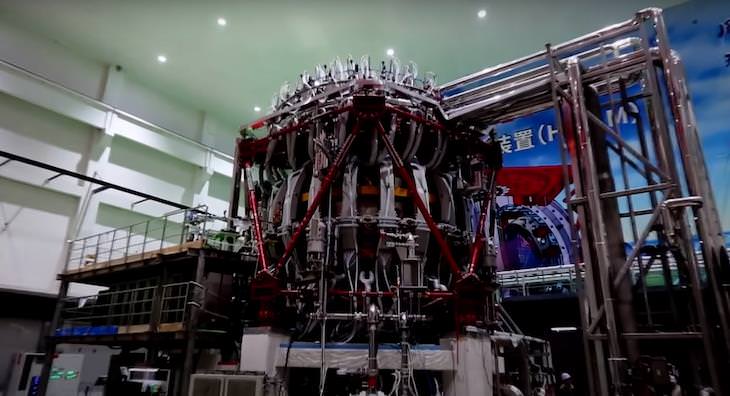
According to media reports from the past weekend, China’s “artificial sun” nuclear fusion reactor, called HL-2M Tokamak, was powered up successfully for the first time. This development is significant as it could revolutionize the way we produce and consume energy.
The reactor uses a powerful magnetic field to fuse hot plasma and can currently reach temperatures of over 280 million degrees Fahrenheit (150 million degrees Celsius). To get some perspective, this temperature is approximately ten times hotter than the core of the sun, hence the nickname 'artificial sun’.
"The development of nuclear fusion energy is not only a way to solve China's strategic energy needs, but also has great significance for the future sustainable development of China's energy and national economy," according to the statement given by the team to People's Daily. In other words, the HL-2M Tokamak could potentially be a powerful and much-needed clean energy source.
The way fusion works is by merging atomic nuclei to create massive amounts of energy - the opposite of the fission process used in atomic weapons and nuclear power plants, which split them into fragments. Unlike fission, fusion emits no greenhouse gases and carries less risk of accidents or the theft of atomic material.
Chinese scientists have been at work on this project since 2006. The plan is to use the device in collaboration with the International Thermonuclear Experimental Reactor (ITER) - the world's largest nuclear fusion research project based in southern France, which is expected to be completed in 2025, and its total cost is estimated to be a whopping $22.5 billion.
Related: 16 Random and Interesting Facts About Nuclear Power

HL-2M Tokamak Image source: YouTube
There are 25 nations overall collaborating in the work on ITER. The goal is to build a device designed to prove the practicality and usefulness of fusion as a carbon-free source of energy based on the same principle that powers our Sun and stars.
"ITER will be the first fusion device to maintain fusion for long periods of time. And ITER will be the first fusion device to test the integrated technologies, materials, and physics regimes necessary for the commercial production of fusion-based electricity," writes the project's website.
Time will tell whether nuclear fusion becomes a viable and affordable source of energy production, but China’s recent achievement with HL-2M Tokamak and its forthcoming collaboration with ITER is certainly an important and fascinating step forward.
Cover image source: Interesting Engineering/ Chinese Academy of Sciences
Share this news with family and friends

The Future of Wind Power Can Be Shaped By This Energy Kite
Here is a look at the the fascinating new wind energy kites that can shape the future of wind power.

New Bionic Eye Developers Say It Will Cure Millions
Scientists are developing an artificial eye, that can potentially eliminate blindness and transform robotics!

Scientists Develop 'Flying Dragon' Robot to Fight Fires
Scientists in Japan have created a water-spitting 'flying dragon' robot to fight fires.

Meet the Fish That Can Help Hold Back Aging in Humans
A recent study has revealed that African turquoise killifish are able to arrest the growth of their embryos for a long time.

7 Happy News Stories You Won't Be Able to Resist Sharing
Watching the news lately can make you feel like only terrible things are happening in the world, so here are 7 really good things that are going on right now.

Is Google Going to Demand Payment for Its New Searches?
Google might start charging for access to search results that use generative artificial intelligence tools.
 4:13
4:13
What Does Medicine ACTUALLY Do In the Body? Fascinating.
What really happens in our bodies when we take medicine, have you ever wondered? This video will answer your question.
 12:38
12:38
Revolutionize Your Green Space: 12 Cool Garden Gadgets
Take your garden to the next level with the amazingly cool inventions and gadgets.
 1:22
1:22
Are Smartphones Making Us Stupid? This Will Surprise You!
If you use a smartphone you need to see this!

Ancient Skull Found In China Unlike Any Human Ever Seen
A newly-discovered skull in China had baffled scientists. This could mean we might have discovered an entirely new species of humans.

How Your Eye Came to Be the Color It Is...
Why do we have different-colored eyes, and what does it mean?

These Photos Show How Dependent We are On Smartphones
Technology has taken over and these funny (but true) photos help to drive this fact home.
 1:44
1:44
The Accidental Discovery of the World’s First Antibiotic
Not too long ago, it was fairly common to die of the simplest of wounds due to bacterial infection. Penicillin changed everything.

Is it REALLY the Coffee that Wakes Us Up in the Morning?
A recent study has revealed that the coffee you drink may just be a placebo...

12 Earliest Versions of Tech Inventions We Use Every Day
Witness the evolution of 11 popular devices we use all the time by looking at how they all started...
 4:52
4:52
Are There Universal Expressions of Emotion? Find Out Here!
Do facial expressions look the same and communicate the same meaning wherever you are in the world? Find out here!
 5:50
5:50
Scientists Finally Know Why We Love Cute Things
We find some things to be irresistibly cute. But why? Let’s find out.

Researchers Claim This Ingredient Can Cure Depression!
A preliminary study has suggested that magic mushrooms may be able to soothe the symptoms of depression. Read here to find out more.

19 Everyday Items That Started as Military Inventions
Look around your home, and you’ll surely find a handful of these items that were originally developed for the armed forces.
 6:31
6:31
The Psychology Behind Why Some People Are Habitually Late
Now we finally know why some people are habitually late.
 8:11
8:11
Fascinating: What is the Deepest Hole Humanity Has Dug?
This video explains how low humanity has dug down so far.

These 11 Brain Facts Are Enough to Boggle Your Mind
When you consider the sheer complexity of the human brain, it's difficult to wrap your head around it. Learn these 11 fascinating facts about the human brain.
 15:37
15:37
These Expensive Megaprojects Proved to be a Waste of Time
Not all megaprojects are useful. Here are some worthless ones.

6 Remarkable Yet Overlooked Minds That Shaped Our World
These underappreciated geniuses deserve more recognition.

The History of Our Planet in One Beautiful Spiral...
This beautiful infographic offers us a remarkable story – the history of Planet Earth.

8 Lies We've Been Told About Electricity
These incorrect facts about electricity have been perpetuated long enough. It's time to disprove them.
 13:01
13:01
Understanding the Aging Process of Our Body Parts
Find out how every organ and body part in our body changes with age.

These Things All Say Something About Your Body Or Mind
There are many things that you can determine about your body and mind just by looking at yourself. Here are 10 things that your body says about you.
 9:39
9:39
Science Lesson: How Does Laser Tattoo Removal Work?
How laser removal of tattoos actually works. These guys are going to find out and explain it to us.

INTERACTIVE: How Personal Items Have Changed Over Time
Some of you will be old enough to remember what many of today's objects used to look like. Here are 20 such objects. Click to see them as they used to be.

10 Real-Life Technologies That Science Fiction Foretold
Sometimes even the wildest science-fiction predictions about the future come true.
 3:16
3:16
You Wouldn't Believe How Far Technology Has Come
Take a look at the advancements of technology in this video. Impressive.
 3:53
3:53
Are You a Late Sleeper? This Super Video Explains Why
Why is it that some people are late risers, and some are morning people? It's all down to our genetics. Have a look here to find out more.

20 Useful Facts About the Science of Cooking
The science behind cooking is not often thought of, but it plays a crucial role in a dish turning out right. Here are 20 facts on the science of cooking.

The Facts You Didn't Know About the Human Body...
Discover 120 fascinating and surprising facts about your body you may not have known. Going over most of the body parts, you will learn so much you never knew about the body we all use.

These Archaeological Finds Left the World Mystified
Find out more about the most mysterious discoveries that archaeologists made.

Can One Photo Really Tell How Good Your Eyesight Is?
Scientists say that this single photograph can tell you whether you have good vision or not. Who can you see in the image?
 8:14
8:14
What Would You Do if You Had an Extra Thumb?
This revolutionary invention has the potential to revolutionize the field of prosthetics.

There are Some Great Secrets Found in Mathematics...
Numbers hold some great secrets - they even tell us about life!
 9:05
9:05
A Tunnel Built by a Swarm of Robots - Jaw-Dropping!
Imagine a swarm of robots attacking a mountain and smashing it to pieces...
 26:43
26:43
These 20 Tech Inventions Will Define the Next Decade
The future is here. Check out some emerging technologies that are all set to chane our world forever.
 2:34
2:34
Let's Talk About Size, From Big to Huge.
an incredible discovery that leads us to a better and better understanding of these objects' true size.

These Ancient Inventions Have Got Scientists Stumped!
Here are 12 items from long ago which prove that our ancestors possessed knowledge and skills far more advanced than we once believed them to be.

25 Pics Showing How People in the Past Imagined the Future
Let’s see how the people of the past imagined the future and find out if their fun predictions came true with these 25 vintage pictures
 1:11
1:11
The COOLEST Flames in the World - Jaw-Dropping!
Have you ever seen a flame as epic as this? Find out how it's made...

Wonder Why Time Speeds Up As You Age? Here's the Answer
We all get the sensation that time moves faster as we get older, but there are scientific reasons for that. Read on to learn about this fascinating phenomenon.
 16:28
16:28
This Secret Invention Changed the Course of WW2
Let’s take a closer look at the proximity fuze, also called Vt Fuze, an invention that changed the course of the second World War.


